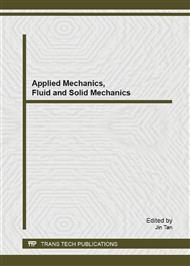p.296
p.304
p.310
p.315
p.323
p.330
p.338
p.342
p.347
A Study on Analysis Method Considering Camber for the Carbody Deflection of the Urban Transit Vehicles
Abstract:
The carbody structure of electric multiple unit (here in after EMU) shall be designed withstand the loading conditions without permanent deformation or any form of damage. And the carbody shall have a minimum design life of 25 years or more in Korea. Loading conditions have a longitudinal compressive force and a vertical load. Camber of the carbody is defined as its curved shape viewed in side elevation. Carbody camber shall be a smooth arc from end to end of the carbody and shall be measured from a datum line drawn between the intersections of the arc with the center lines of the carbody bolsters to a line tangent to the arc midway between bolsters. The carbody shall be built with positive camber such that camber shall remain positive with the carbody at maximum load and shall not bind due to deflection caused by variations of service load. To assess the strength and stiffness of the designed carbody, carbodys designer shall be demonstrated by a programme of finite element analysis and testing shall be carried out in accordance with Korean standard technical specifications. The carbody is manufactured by giving the slope of the deflection to be compensated strength and stiffness. The deflection is camber. So this study analyzes that how camber affects safety and durability of carbody according to the load conditions and revenue service on main-line. Methods and analytical model of carbody structure is introduced to demonstrate them.
Info:
Periodical:
Pages:
323-329
Citation:
Online since:
December 2013
Authors:
Keywords:
Price:
Сopyright:
© 2014 Trans Tech Publications Ltd. All Rights Reserved
Share:
Citation:


